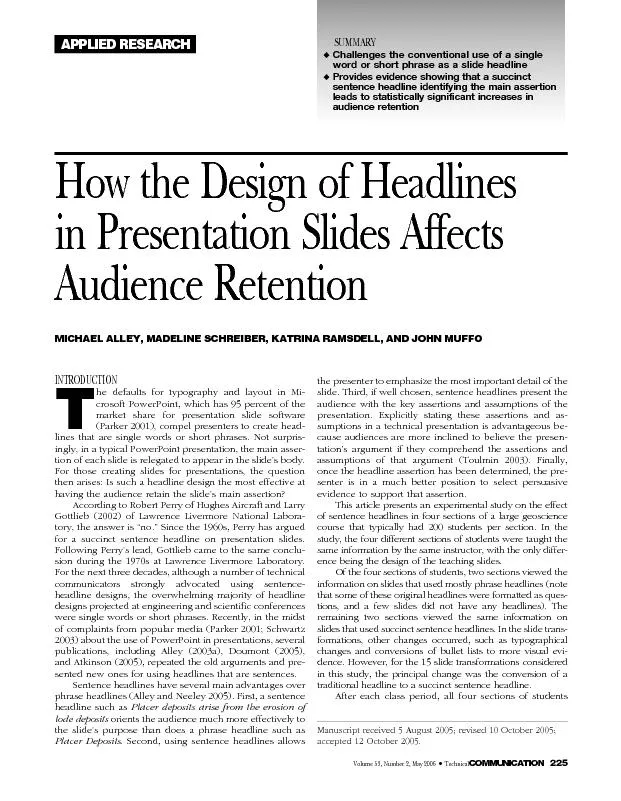

HowtheDesignofHeadlines Manuscriptreceived5August2005revised10October2005accepted12October2005Volume53Number2May2006COMMUNICATION225 hadaccesstocopiesoftheslidesthattheinstructorhadprojectedThen ID: 288363
Download Pdf The PPT/PDF document "APPLIEDRESEARCHChallengestheconventional..." is the property of its rightful owner. Permission is granted to download and print the materials on this web site for personal, non-commercial use only, and to display it on your personal computer provided you do not modify the materials and that you retain all copyright notices contained in the materials. By downloading content from our website, you accept the terms of this agreement.
APPLIEDRESEARCHChallengestheconventionaluseofasinglewordorshortphraseasaslideheadlineProvidesevidenceshowingthatasuccinctsentenceheadlineidentifyingthemainassertionleadstostatisticallysignificantincreasesinaudienceretention HowtheDesignofHeadlines Manuscriptreceived5August2005;revised10October2005;accepted12October2005.Volume53,Number2,May2006COMMUNICATION225 hadaccesstocopiesoftheslidesthattheinstructorhadprojected.Thenafterthefiveclassperiods,thestudentstookanexamthataskedthemtorecallasetofassertionsfromthoseslides.Forthoseinthetwosectionstaughtfromthetraditionallydesignedslides,theassertionsresidedinbodiesoftheslides,whileforthestudentsinthesentence-headlinesections,thesameassertionsresidedintheslidessentenceheadlines.Thecoursesfinalexamination,whichoccurredafewdaysafterthefinalclassperiod,servedastherecalltest.Thiscaseofanaudienceviewingasetofslidesandthenhavingaccesstothoseslidesasasetofnotesiscommoninscienceandengineering.Granted,thewaythatstudentsstudytheirsetofnotesforafinalexamisquitedifferentfromthewaythattechnicalprofessionalswouldrefertotheirsetsofnotes.Nonetheless,theresultspre-sentedherehaveimplicationsinthewaythattechnicalprofessionalsshoulddesignslides.Forinstance,ifthestudentswhoweretaughtfromtheslideswithsentenceheadlinesrecalledsignificantlymoreinformationthanthosestudentswhoweretaughtfromslideswithphrase,question,ornoheadlines,thentechni-calpresentersshouldconsiderusingsentence-headlinede-signs.Insuchacase,giventhattheoverwhelmingmajorityoftechnicalpresenterscurrentlyusephraseheadlines,theincreaseintheamountoftechnicalinformationcommuni-catedinengineeringandsciencecouldbelarge.Thenextsectionofthisarticledescribesthedesignofthestudy.Includedinthissectionisajustificationoftheparticularsentence-headlinedesignselectedforthestudy,thecontrolmethodusedtoassesstherelativestrengthsofthefourstudentgroups,andakeyassumptionaboutthetests.Followingthissectionarethestudysresults.Attheheartofthissectionisanexplanation,fromacommunica-tionperspective,ofwhythestudentswhoviewedthesentenceheadlinesrecalledtheslideskeyassertionsatlevelsthatweredifferentfromthosewhoviewedslideswithphrase,question,ornoheadlines.EXPERIMENTALMETHODSThisstudyconsideredtheeffectonaudienceretentionofusingasentence-headlinedesignfortheteachingslidesinalargegeosciencecourseatVirginiaTech.Thiswasanintroductorycoursethatdiscussedtheorigin,distribution,anduseoftheearthsresources.Becausethecoursesatis-fiedoneoftheuniversitysgeneraleducationrequirements,itwasapopularcoursefornon-majors,attractingstudentsfromallbranchesofscienceandengineering,aswellasthosefromliberalarts,agriculture,andbusiness.Thecoursewasexcellentforthispilotstudybecausetheinstructorusedcomputer-generatedprojectionsofslidesastheprincipalvisualaidinmostclassperiods.Forthatreason,theslidesplayedanimportantroleintheinstruction.Otherreasonsthatthecoursewasagoodchoiceforthisstudywerethattheexaminationshadmultiple-choicequestions,thestudentstookexaminationsonsheetsthatcouldbecomputerscored,andtheinstructorhadexaminationsgradedthroughtheuniversitytestingcenter,wheretheresultsofpriorexaminationsexist.Fromtheseexaminationresults,wewereabletoextractstatisticsdirectlylinkingtestquestionstopresentationslidesfromearliersemesters.ShowninFigure1isavisualdepictionofhowthestudywasperformed.Forthestudy,wetransformedabout100teachingslidesfromthefourthandfinalportionofthecoursetothesentence-headlinedesign.Notallthetransformationsin-volvedthesametypesofchanges.Intheinstructorsoriginaldesignofslides,about80percentoftheslideshadphraseheadlines;theremaining20percenteitherhadnoheadlinesorhadheadlineswrittenasquestions.Inthetransformedversions,100percentoftheslides,exceptforthetitleslideofeachclassperiod,containedsuccinctsentenceheadlines.Inaddition,about40percentoftheoriginalslidescon-sistedofthetraditionalbulletlistinthebody,withtheremain-ing60percenthavingatleastoneimage.Inthetransformedversions,100percenthadtheevidenceofitsslidebodiespresentedinavisualwaywithoutanybulletlistsbeingused.Nodoubtthesevisualchangestotheslidebodiesaffectedaudiencerecall(Alley,Schreiber,andMuffo2005).However,forthe15slidetransformationstestedforthisstudy,theprincipalchangewastheconversiontoasuccinctsentenceheadline.Moreover,forthose15transformedslides,theas-sertionsthatthestudentshadtorecallresidedinthesentenceheadlines,whileforthecorrespondingtraditionalslides,those Figure1.Visualdepictionofthestrategyforthestudy.Theisolateddifferencebetweenthepresentationsoftheinformationwasthedesignoftheslides.APPLIEDRESEARCH HeadlinesinPresentationSlidesandAudienceRetentionAlleyandColleaguesCOMMUNICATIONVolume53,Number2,May2006 assertionsresidedinthebodiesoftheslides.Usingthetransformedslides,theinstructortaughttheclassesinthesamewaythatshehaddoneinpastsemes-ters.Ofparticularimportance,asshehaddoneinpastsemestersandintheotherlecturesthatsemester,shepostedherslidesontheWebsothatstudentscoulddown-loadtheslidesafterthelecturestouseasstudyaids.JustificationofselecteddesignThesentence-headlinedesignchosenforthisstudyhasachievedmuchanecdotalsuccess(AlleyandNeeley2005).Onefeatureofthisdesignisitssetofspecificguidelinesfortypography(Alley2003a).Forinstance,onesuchguidelineisthatthesentenceheadlineberestrictedtonomorethantwolines.ThisguidelineagreeswithDoumontsrecom-mendation(2005)fortextblocksonapresentationslide.Asecondtypographyguidelineistheuseofaboldsansseriftypefacefortheheadline.Thisguidelinearosefromourownobservationthataboldfacesansseriftypefaceiseasiertoread,inalargeroom,thaneitheranormalsansseriforanormalorboldfaceserifformattedatthesametypesize.Inassessingtheeaseofreadingfordifferenttypefacesintheroom,wepositionedourselvesbothattheback-rowseatsmostdistantfromthescreenandatthefront-rowseatswiththesharpestanglestothescreen.Yetathirdtypographyguidelineisleftjustifyingtheheadlinewithabeginningpositionintheslidesupperleftcorner.ThisguidelineagreeswiththerecommendationsofGottlieb(2002)forsentenceheadlines.Asecondfeatureoftheslidedesignchosenforthisstudyisthattheheadlinebesupportedbyvisualevidence,asopposedtoabulletlist.ThisaspectagreeswithoneofRichardMayersprinciples(2001)formultimedianamely,thatstudentslearnbetterfromwordsandrepresentativeimagesthanfromwordsalone.TheslidedesignchosenforourstudyalsofollowstwomoreofMayersprinciples:(1)thatstudentslearnbetterwhenimagesareplacednearratherthanfarfromthecorrespondingtext;and(2)thatstudentslearnbetterwhenimagesandcorrespondingtextarepresentedsimultaneouslyratherthansuccessively.TheslidesofFigure2showthedifferencesbetweenthetradi-tionaldesign(top)andthesentence-headlinedesignse-lectedforthisstudy(bottom).ControlgroupforthestudyThefinalexaminationsforthefourdifferentsectionsofthecourseconsistedof100questions:60questionsbasedonthecontentforthecoursesfourthandfinalportion,and40questionsdrawnfromthequestionsalreadyposedtothestudentsonthesemestersthreeearliertests.Giventhisstructure,wechosetheaveragescorethateachclasshadonthe40questionsfromtheprevioustestsasameansforcontrollingtherelativeeffortofeachsection.Wechosetheaveragescoresforthese40questionsasthecontrolmea-surebecausestudentsinallfoursectionspreparedforthisportionoftheexaminationbystudyingtheprevioustestsofthesemesterratherthanbystudyingtheslidesthataccompaniedthatmaterial.Forthatreason,theresultsonthissectionoftheexamprovidedanexcellentwindowintotheeffortgivenbyeachsectionofstudents.Table1presentsasummaryoftheaveragesobtainedbyeachofthefoursectionsforthose40questions.AsseeninTable1,theFall2004andSpring2005sectionsachievedlowerscoresthantheFall2003andSpring2003sectionsdid.Forthatreason,weconcludedthatthetwolatersec-tions,whichweretaughtwithsentence-headlineslidesinthefourthandfinalportionofthesemester,didnotputforthanymoreeffortinpreparingfortheexamthandidthetwoearliersections,whichweretaughtthesamematerialfromslidesdesignedinatraditionalway. Figure2.Transformationofoneofthetraditionallydesignedslides,shownatthetop,tothesentence-headlinedesignshownatthebottom(Schreiber2005).APPLIEDRESEARCH HeadlinesinPresentationSlidesandAudienceRetentionAlleyandColleaguesVolume53,Number2,May2006COMMUNICATION227 KeyassumptioninthestudyRichardMayer(2001)hasperformedseveralexperimentalstudiesontheeffectofmultimediaonlearninglearningfromwordsandpicturesasopposedtolearningfromjustwords.InMayersstudies,eachlearnerreceivedexactlythesamewords(eitherwritten,spoken,orboth)becausethespokenwordswerenarrated,ratherthanpresented.May-ersstudiesprovideavaluablebaseofknowledgeonhowwords(writtenandspoken)andimagesaffecthowmuchpeopleunderstandandrecall.However,thecommunica-tionsituationsofMayersstudiesarequitedifferentfromthecommunicationsituationsthatmosttechnicalprofes-sionalsface.Forinstance,becausethespeechinMayersstudieswasrecordedandplayedtotheaudience,thespeechwasperfectexactlywhatthepresenterwantedtheaudiencetohear.Incontrast,inatypicaltechnicalpresentationsuchasthepresentationofscientificresearchataconferenceorofanengineeringdesigntomanagers,thepresenterspeaksfrompointsorslides.Becausenoteverywordisscripted,thewordingisnotexactlythesamefromonepresentationofthematerialtoanother.Moreover,thespeechissome-timesinfluencedbytheaudienceeitherthepresenterreactingtotheexpressionsoftheaudienceor,duringaninformalpresentation,thespeakerrespondingtoquestionsinterjectedbytheaudience.Inaddition,inmosttechnicalpresentations,thepresenternotonlyhastoinformtheaudienceabouttheinformationbutalsohastopersuadetheaudienceaboutthatinformation.Forthatreason,thepresenterhastobuildcredibilitywiththeaudience.Inbuildingthatcredibility,thepresenteroftenincludesdetailsthatarebeyondwhattheaudienceneedstounderstandthecontentastrategythatgoesagainstMayersprincipleofexcludingextraneouswords(2001).Thestudypresentedinthisarticleismuchmorelikethetypicalsituationthattechnicalpresentersfaceinthatthepresenterdeliveredherclasslive,ratherthantaped.Giventhatliveelement,though,eachsectiondidnotex-perienceexactlythesamespeech.Moreover,inourstudy,studentsindifferentsectionsaskeddifferentquestions,whichcausedsomepointstobeemphasizedmorethanothers.Finally,fullattendancedidnotoccurduringeveryclass,whichmeantthatsomestudentslearnedportionsofthematerialjustfromthepostedslides,asopposedtolearningthematerialfromboththeclassroompresentationandthepostedslides.Despitetheseirregularitiesinthespeechexperiencedbytheaudience,akeyassumptionofthisarticleisthatthedesignofslideswasthemajordifferenceinthelearningthatoccurredamongthefoursections:theSpring2003andFall2003sectionsthatlearnedfromslidesmostlywithphraseheadlines,andtheFall2004andSpring2005sec-tionsthatlearnedfromsentence-headlineslides.Putan-otherway,thestudentsintheselargesectionsexperienced,onaverage,thesamespeech.Supportingthisassertionistheoverallconsistencyintestscoresinwhichthedifferentsectionswitnessedthesameinformationpresentedontheslidesinessentiallythesamewayandansweredthesamequestionsthatarosefromthoseslides.Examplesofconsistencyincludethesixexamques-tionsthatrequiredthestudentstorecallinformationfromimagesonslidesthatcouldbefoundonboththetraditionalslidesandthesentence-headlineslides.Fortheseques-tions,thescoreswereclose,withanaveragecorrectscoreof86%forthosestudentslearningfromthetraditionalslidesand87%forthosestudentslearningfromthetrans-formedslidesadifferencethatisnotstatisticallysignifi-cant.Thatthescoresweresocloseisnotsurprisingbe-causethetransformationsdidnotmakeasmuchofadifferenceontheseslides.Theinformationtoberecalledwasnotdirectlystatedinthesentenceheadline,andtheimageswerethesame.TABLE1:SCORESFORDIFFERENTSECTIONSONCONTROLQUESTIONS No.ofStudentsClassTimeClassScore:ControlQuestionsSpring20032002:303:45.87.9%Fall200320212:301:45.86.1%Fall200420112:301:45.82.5%Spring20051368:009:15.79.1%APPLIEDRESEARCH HeadlinesinPresentationSlidesandAudienceRetentionAlleyandColleaguesCOMMUNICATIONVolume53,Number2,May2006 first-leveldetail.Thatsortofcatalogingwouldcontrastwiththewaythatthestudentsviewingthephrase-headlineslidesmighthavecatalogedtheinformation.Thephrase-headlinestudentsmighthavecatalogedthedetailasasecond-leveldetailbeneaththefirst-levelheadingofiron.Asasecond-leveldetail,itwaslesslikelytoberecalled.Forfiveofthe10questionsthatinvolvedtransforma-tionsofphraseheadlinestosentenceheadlines,thestu-dentstaughtfromthesentence-headlineslidesachievedhigherscoresthatwerestatisticallysignificant.Inturn,ononlyonequestiondidthesestudentsachievelowerscoresthatwerestatisticallysignificant.TheonequestionforwhichtherewasasignificantdecreaseinrecalloccurredwiththeSpring2003section(phraseheadline)achievingasignificantlyhigherscorethantheFall2004sectiondid(sentenceheadline).Interestingly,onthatsamequestion,theSpring2005section(sentenceheadline)actuallyachievedahigherscorethandidtheSpring2003section(phraseheadline).Ineffect,althoughtheFall2004andSpring2005studentsweretaughtfromthesameslideonthisquestion,theSpring2005studentsscoredmuchhigherthantheFall2004onesdid.Asmentioned,whenstudentsfromdifferentsectionsviewedthesameslidesandwereaskedtorecallthesameinformationfromthoseslides,thescoresweregenerallyaboutthesame.However,thiscasewasclearlyanexception.TABLE2:COMPARISONOFTESTSCORESFORTHOSETAUGHTFROMTRADITIONALHEADLINESVERSUSSCORESFORTHOSETAUGHTFROMSENTENCEHEADLINES OriginalFormofHeadlinePercentageCorrectforTraditionalHeadlinePercentageCorrectforSentenceHeadlineSignificanceLevelofStatisticalDifferenceNone23%57%0.001Question24%58%0.001Phrase61%85%0.001Phrase46%63%0.005Phrase71%85%0.005Phrase75%89%0.005Phrase79%89%0.025Phrase79%86%notsignificantPhrase80%85%notsignificantPhrase74%79%notsignificantNone67%72%notsignificantQuestion96%99%notsignificantPhrase86%81%notsignificantQuestion96%89%0.01Phrase79%63%0.0169%79%0.001APPLIEDRESEARCH HeadlinesinPresentationSlidesandAudienceRetentionAlleyandColleaguesCOMMUNICATIONVolume53,Number2,May2006